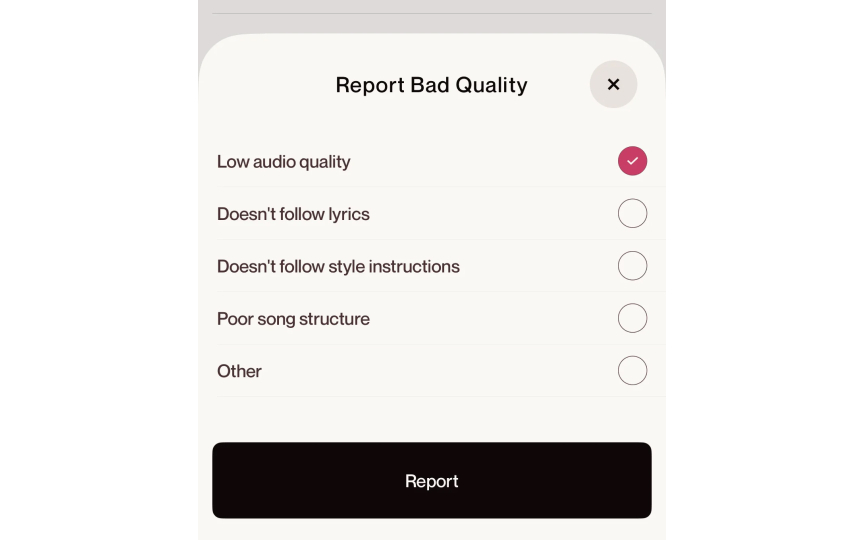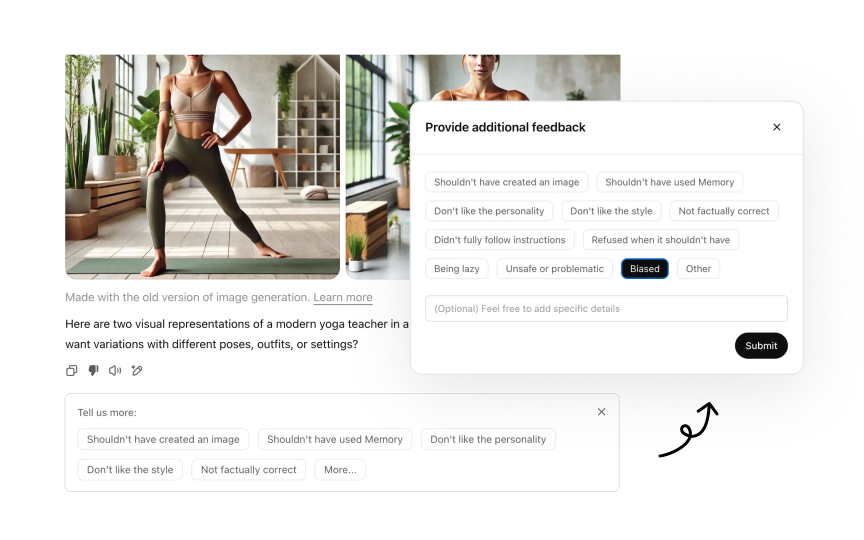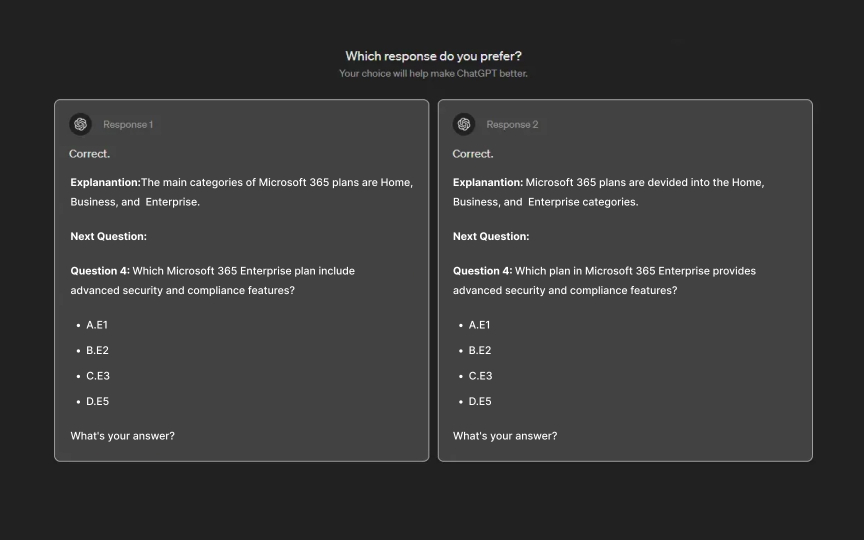Feedback Loops & Transparency
Build trust and continuous improvement through transparent AI systems and effective feedback mechanisms.
Transparency and feedback loops build trustworthy AI systems that get better over time. Making AI decisions understandable while creating ways for continuous improvement affects both user trust and how well systems work. Good AI interfaces show model confidence, reasoning paths, and data sources to help users understand results. Even complex "black-box" models become more trustworthy through simpler examples that explain their behavior. These clear systems work best when combined with feedback channels that gather both automatic signals (clicks, usage patterns) and direct input from users.
Showing users how their feedback changes the system builds trust and involvement. People naturally care more about systems when they can see their impact through visual displays of improvement or updates about new features their feedback helped create. This mix of transparency and meaningful feedback creates positive cycles where AI and humans help each other improve, creating systems that become more valuable each time they're used.
- Diminishing response rates to feedback requests
- Inconsistent quality of submitted feedback
- Stagnating system performance metrics despite continued user engagement
Models trained with reinforcement learning from human feedback (RLHF) are particularly dependent on feedback quality. They can only improve to the extent that feedback accurately guides them toward better outputs.
Teams need to establish baseline metrics for healthy feedback loops and regularly monitor key indicators such as feedback diversity, user participation rates, and the impact of feedback on model performance.
Without this vigilance, AI systems risk becoming stagnant, repeating the same patterns and mistakes. Addressing decay requires refreshing feedback collection methods, engaging new user segments, changing the presentation of feedback requests, and sometimes temporarily increasing incentives.
Some platforms implement rotating feedback mechanisms, presenting different formats to prevent user fatigue. Others use adaptive scheduling that adjusts feedback frequency based on individual user behavior rather than bombarding everyone with the same requests.
Passive behavioral signals form an invisible layer of feedback that
- Navigation patterns
- Feature usage frequency
- Time spent on different screens
- Scroll depth
- Hover patterns
- Task completion rates
Unlike ratings or reviews, this feedback happens naturally as users interact with a system, making it invaluable for understanding actual behavior rather than reported preferences. For example, recommendation systems learn from which items users click on, how long they engage with content, and whether they return to similar items later.
Effective passive signal collection requires thoughtful instrumentation of interfaces to capture meaningful events without overwhelming data pipelines with noise. Designers must identify which behaviors genuinely indicate user satisfaction or frustration. Abandoning a task halfway might signal confusion, while rapidly completing a workflow might indicate mastery or, alternatively, desperation to finish quickly. Context matters tremendously. The best systems combine multiple behavioral signals to form more reliable indicators of user intent and satisfaction rather than over-interpreting any single metric. This approach provides continuous feedback without the fatigue associated with constantly asking users for explicit
Explicit feedback mechanisms give users direct channels to evaluate, correct, or enhance
- Binary options like thumbs up/down buttons work best for quick, emotional reactions when users are unlikely to invest time in detailed feedback.
- Numeric rating scales (1-5 stars, 0-10 ratings) allow for greater nuance while remaining low-effort.
- Categorical feedback lets users specify why something worked or didn't work without open-ended writing.
- Free-form text fields for detailed feedback provide the richest information but require the highest user effort. They capture nuanced explanations, edge cases, and unexpected issues that structured formats might miss. These work best when users are highly invested in improving the system or have encountered unusual problems worth explaining.
The placement and timing of these mechanisms significantly impact response rates. Feedback requests that appear immediately after value delivery, such as right after an AI generates a helpful response, tend to receive higher engagement. The visual design matters too.
Reinforcement Learning from Human Feedback (RLHF) has become a standard approach for improving
This specific categorization provides much more valuable training data than a simple negative rating alone. To maximize the quality of collected feedback, interfaces should clearly explain how user contributions help improve AI technology, motivating people to provide thoughtful responses rather than reflexive ratings.
Collaborative training workflows engage users in providing feedback on
While the AI system doesn't learn immediately from this feedback, companies collect these user evaluations to improve future versions of their models through reinforcement learning from human feedback (RLHF). Over time, as thousands of users provide these preference judgments, the collective feedback helps AI developers understand which responses users find most helpful, accurate, safe, and aligned with human values. This creates a system where user
Black box
This perspective shift can lead to more trustworthy AI systems without sacrificing accuracy, particularly for decisions with significant human impact. Rather than accepting black boxes as inevitable for complex problems, we should assume interpretable alternatives exist until definitively proven otherwise.[1]
Pro Tip: Always try simple, clear models first before using complex black box systems. Only use black boxes if simpler options clearly don't work well enough.
The complexity of black box models enables them to handle vast amounts of information and identify patterns that humans might miss, but it comes at the cost of understanding how decisions are made. They're particularly popular for tasks like image recognition, language translation, recommendation systems, and voice assistants. Companies sometimes choose black box models because they believe these models offer better accuracy, especially for complex problems.
In some cases, companies prefer black box models because they keep their methods secret, protecting their business advantage. However, in areas where decisions greatly affect people's lives, such as loan approvals, medical diagnosis, or criminal justice, using unexplainable models creates serious ethical concerns, since people affected by these decisions deserve to understand how they were made.
The hidden nature of black box
Black box models can hide bias. They might make unfair decisions based on race, gender, or other factors without anyone noticing. For example, AI hiring systems have rejected qualified women because they were trained on data from mostly male hires.
These models may also fail unpredictably in new situations they weren't trained for. Finally, black box models make it hard to meet regulations that require companies to explain important decisions about loans, insurance, or employment.
White box
References
- Why Are We Using Black Box Models in AI When We Don’t Need To? A Lesson From an Explainable AI Competition | Harvard Data Science Review
Top contributors
Topics
From Course
Share
Similar lessons

AI’s Role in Text Generation and Modification

Best Practices and Potential Pitfalls of AI Writing Tools






















